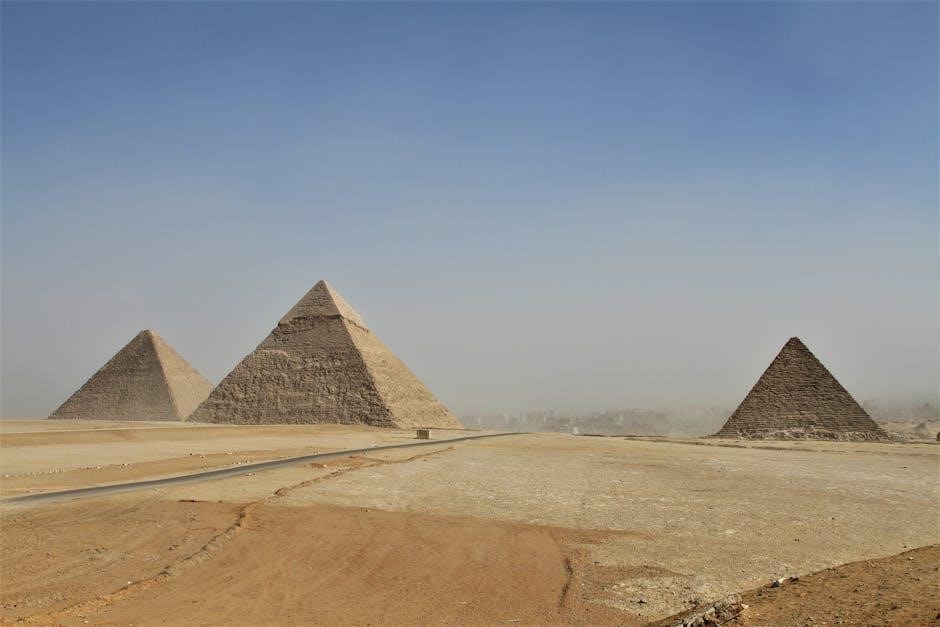The 7 Cs of History provide a biblical framework for understanding the universe’s history, from Creation to Consummation, offering a structured approach to key events.
1.1 Overview of the 7 Cs Framework
The 7 Cs of History framework organizes biblical history into seven key events: Creation, Corruption, Catastrophe, Confusion, Christ, Cross, and Consummation. This structure provides a clear and structured way to understand the major events of the Bible, from the creation of the world to its ultimate restoration. Each “C” represents a pivotal moment in the biblical narrative, offering a comprehensive overview of God’s plan and humanity’s relationship with Him.
1.2 Importance of Understanding Biblical History
Biblical history is foundational for comprehending the Bible’s message. It reveals God’s character, humanity’s condition, and His redemptive plan. Understanding this history provides a basis for faith, helps explain life’s purpose, and equips believers to share the Gospel effectively. It also offers a unified narrative, contrasting with secular views, and underscores the significance of Christ’s sacrifice and the promise of future restoration.
The First C: Creation
The first C, Creation, is the foundation of history, detailing God’s six-day creation of the universe and rest on the seventh day, as recorded in Genesis 1.
2.1 Genesis 1: The Six Days of Creation
Genesis 1 describes God’s creation of the universe in six days, each day focusing on a specific aspect: light, sky, land, plants, sun, moon, stars, animals, and humans. On the sixth day, God created mankind in His image, granting dominion over the earth. The seventh day was a day of rest, sanctified by God. This account forms the foundation of the biblical view of history, emphasizing God’s deliberate and purposeful creation of all things.

2.2 The Seventh Day: Rest and Sanctification
Genesis 1 highlights the seventh day as a day of rest, where God sanctified and blessed it, ceasing from His creative work. This day signifies the completion of creation and establishes a pattern for humanity to rest. Theologically, it underscores God’s sovereignty and the importance of observing the Sabbath, reflecting humanity’s need for rest and worship. This rest is not due to fatigue but a deliberate act, emphasizing trust in God’s provision and order.
The Second C: Corruption
Corruption marks the second phase, where Adam and Eve’s disobedience introduced sin, leading to a fractured relationship with God and the entrance of evil into the world.
3.1 The Fall of Man in Genesis 3
In Genesis 3, the Fall of Man occurs as Adam and Eve disobey God by eating the forbidden fruit. This act of rebellion introduces sin, leading to a cursed earth, suffering, and separation from God. The consequences of their actions affect all humanity, establishing a broken relationship with God and paving the way for the need for redemption. This event marks the beginning of corruption in the world, setting the stage for future biblical events.
Genesis 3 introduces sin as Adam and Eve disobey God, leading to a broken relationship with Him. Their rebellion results in a cursed earth, suffering, and death. Sin becomes inherent in humanity, affecting all descendants. This corruption separates mankind from God, creating a need for redemption. The consequences of sin are far-reaching, impacting every aspect of creation and setting the stage for the biblical narrative of redemption through Christ. This event forever alters the course of human history.

The Third C: Catastrophe
The Great Flood in Genesis 6-8 represents a catastrophic judgment on humanity’s wickedness. God resets creation, saving Noah and his family to preserve life and redemption.
4.1 The Great Flood in Genesis 6-8
The Great Flood, described in Genesis 6-8, was a catastrophic judgment by God on humanity’s wickedness. Seeing the earth corrupted by sin, God instructed Noah to build an ark to save his family and two of every kind of animal. The flood lasted 40 days and nights, destroying all life except those on the ark. This event reset creation, demonstrating God’s justice and mercy. It serves as a pivotal moment in the biblical narrative, emphasizing divine judgment and redemption.
4.2 The Destruction of Sodom and Gomorrah
The destruction of Sodom and Gomorrah, recorded in Genesis 18-19, marks another catastrophic judgment by God. The cities’ extreme wickedness and sexual immorality provoked divine wrath. God sent fire and sulfur from heaven, annihilating the cities and their inhabitants. Lot, Abraham’s nephew, was rescued due to his righteous living. This event underscores God’s justice and serves as a warning against sin. It aligns with the biblical view of history, contrasting with secular interpretations that often dismiss such accounts as myths.

The Fourth C: Confusion
Confusion marks the fourth C, highlighting God’s judgment at Babel in Genesis 11. Humanity’s pride led to scattered nations and confused languages, halting their unified rebellion.
5.1 The Tower of Babel in Genesis 11
Genesis 11 recounts the story of the Tower of Babel, where humanity, united in pride, sought to build a towering structure to reach heaven. God, seeing their rebellion, confused their language, causing dispersion and ending their unified endeavor. This event highlights divine judgment on human arrogance and the origin of diverse languages and cultures, reshaping humanity’s trajectory.

5.2 The Dispersion of Nations and Languages
The dispersion of nations and languages followed God’s judgment at Babel, scattering humanity across the earth. This event, described in Genesis 11, explains the origin of diverse cultures and tongues. The confusion of languages halted the unified rebellion, fulfilling God’s plan to populate the earth. This dispersion laid the foundation for the development of distinct nations, aligning with biblical prophecy and setting the stage for God’s redemptive plan through specific people groups.

The Fifth C: Christ
The Fifth C represents the life and ministry of Jesus Christ, fulfilling prophecy and revealing God’s divine purpose for redemption, salvation, and humanity’s restoration through Him.
6.1 The Life and Ministry of Jesus Christ
Jesus Christ’s life and ministry are pivotal in the 7 Cs of History, marking the fulfillment of God’s plan for salvation. Born of a virgin, He lived a sinless life, teaching divine truths and performing miracles that validated His identity as the Messiah. His compassion, wisdom, and authority over sin and death set the stage for the ultimate sacrifice on the cross, providing redemption for humanity and establishing the path to eternal life.
6.2 The Genealogy and Divine Purpose of Christ
Christ’s genealogy, tracing back to Adam and Abraham, underscores His divine purpose as the Messiah. His birth in Bethlehem fulfilled Old Testament prophecies, confirming His identity as the Son of God. The lineage highlights His connection to Israel’s history, emphasizing His role as the Redeemer of humanity. This genealogy is not merely historical but theological, revealing God’s plan to restore humanity through Christ’s life, death, and resurrection, fulfilling the promises of the biblical narrative.

The Sixth C: Cross
The sixth C represents the crucifixion of Jesus Christ, a divine act of sacrifice to atone for humanity’s sin, providing salvation and redemption through His death on the cross.

7.1 The Crucifixion and Atonement
The crucifixion of Jesus Christ, as detailed in the New Testament, was a pivotal event in human history. It symbolized God’s sacrificial love, where Jesus bore the sins of humanity, providing atonement through His death on the cross. This act of redemption fulfilled Old Testament prophecies and established the foundation for salvation, offering forgiveness and reconciliation between God and mankind. The cross represents the ultimate expression of divine mercy and the means by which sin’s consequences were overcome.
7.2 The Resurrection and Its Significance
The resurrection of Jesus Christ is the climax of the sixth C, representing victory over death and sin. This historical event, confirmed by eyewitnesses, demonstrated God’s power and validated Jesus’ divine claims. The resurrection defeated death, fulfilled prophecies, and provided hope for eternal life. It serves as the foundation of Christian faith, offering forgiveness and reconciliation with God, and assures believers of their future resurrection and eternal inheritance.

The Seventh C: Consummation
Consummation marks the ultimate fulfillment of God’s plan, with Christ’s return, final judgment, and the establishment of a new heaven and earth, completing history’s redemptive purpose.
8.1 The Second Coming of Christ
The Second Coming of Christ signifies the triumphant return of Jesus to establish His eternal kingdom. This event marks the culmination of God’s redemptive plan, bringing an end to sin and suffering. According to biblical prophecy, Christ will return in glory to judge the living and the dead, restoring all things. This future event is a source of hope for believers, promising eternal life and a new, sin-free world.
8.2 The New Heaven and the New Earth
The New Heaven and the New Earth represent the ultimate restoration of God’s creation, free from sin and suffering. Revelation 21-22 describes this eternal realm, where God dwells with humanity, eliminating pain, death, and evil. It symbolizes the final consummation of God’s plan, offering believers hope and eternal life in a perfect world, fully reconciled to its Creator.
Biblical View vs. Secular View of History
The Biblical view of history, structured by the 7 Cs, emphasizes divine purpose and supernatural events, while the secular view relies on human reasoning and natural processes.
9.1 Contrasting Perspectives on Historical Events
The Biblical view interprets history through the lens of God’s divine plan, emphasizing supernatural events like Creation and the Flood. In contrast, the secular perspective relies on natural explanations, dismissing divine intervention. While the Bible presents history as purposeful and teleological, secular views often see history as a series of random, evolutionary processes. This fundamental difference shapes how each interprets key events, such as the origin of life, the Tower of Babel, and the role of humanity in the world.

Practical Applications of the 7 Cs
The 7 Cs of History provide a framework for teaching biblical history, enabling effective ministry, and defending the biblical account against secular views, as outlined in the PDF.
10.1 Education and Teaching the 7 Cs
The 7 Cs of History provide a structured approach for educators to teach biblical history effectively. Using the 7 Cs framework, teachers can integrate key events into curriculum, ensuring students understand the biblical timeline. PDF resources, such as study guides and worksheets, are invaluable tools for lesson planning and interactive learning. By emphasizing Creation, Corruption, Catastrophe, Confusion, Christ, Cross, and Consummation, educators can help students grasp the overarching narrative of biblical history and its relevance to modern life.
10.2 Ministry and Evangelism Using the 7 Cs Framework
The 7 Cs of History provide a powerful tool for ministry and evangelism, offering a clear framework to share the biblical narrative. By emphasizing Creation, Corruption, Christ, and the Cross, ministers can present the gospel in a structured, easily understandable manner. This framework helps connect biblical events to the redemptive plan of God, making it effective for evangelistic outreach and discipleship. It also equips believers to articulately defend their faith and share the hope of Consummation with others.
10.3 Apologetics and Defending the Biblical Account
The 7 Cs of History provide a robust framework for apologetics, enabling believers to defend the biblical account against secular perspectives. By emphasizing Creation, Corruption, and Consummation, apologists can address evolutionary theories and historical criticisms. The structured approach offers clear, logical evidence for biblical events, reinforcing the authority of Scripture. This method equips Christians to counter skepticism and present a compelling case for the Bible’s accuracy, ensuring a strong foundation for faith and evangelism.
Resources and Tools
The 7 Cs of History PDF, study guides, and visual aids provide essential resources for understanding and teaching biblical history, enhancing learning and engagement effectively.
11.1 The 7 Cs of History PDF
The 7 Cs of History PDF is a comprehensive guide outlining the biblical framework of history, from Creation to Consummation. It provides a detailed overview of key events, making it an invaluable resource for personal study, education, and ministry. This free downloadable resource is designed to enhance understanding and teaching of the biblical account of history, offering a structured approach to sharing the gospel and defending the biblical worldview effectively.
11.2 Study Guides and Worksheets
Study guides and worksheets complement the 7 Cs of History framework, offering interactive tools for deeper understanding. These resources include activities, discussion questions, and exercises tailored for various age groups. They help students apply the biblical framework to real-world scenarios, reinforcing key concepts like Creation, Corruption, and Consummation. Worksheets also provide practical exercises for memorizing the 7 Cs, making them ideal for educational settings and personal study. These materials enhance engagement and retention of the biblical history narrative.
11.3 Visual Aids and Charts
Visual aids and charts are essential tools for understanding the 7 Cs of History framework. These resources include timelines, diagrams, and infographics that visually represent the sequence of events from Creation to Consummation. Charts highlight key biblical events, such as the Great Flood and the Tower of Babel, while timelines provide a chronological overview. These visual tools enhance comprehension, making complex historical narratives more accessible for learners of all ages. They are particularly valuable for educational settings and personal study, aiding in retention and engagement with the biblical account of history.
